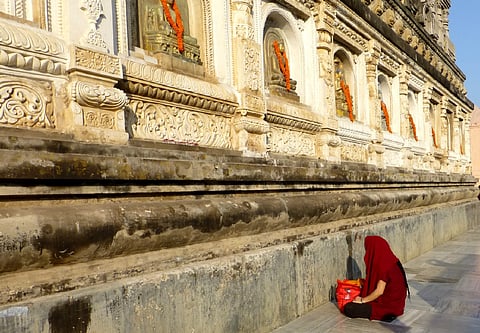In front of the Mahabodhi temple entrance, several Bhikkhus (Buddhist monks) relax over chai, having conversations and entertaining tourists. The Mahabodhi temple is a pilgrimage spot in Bodh Gaya, Bihar. It was given UNESCO World Heritage Site status in 2002. The vast complex attracts millions of Buddhist pilgrims and other tourists from all over the world, especially from countries with majority-Buddhist populations, such as Thailand and Sri Lanka. A debate on Indian civilisation and Buddhism began between the Bhikkhus and a young tourist. One Bhikkhu claimed in a boisterous tone, "Buddhism is older than Hinduism, the excavation from the Harappan civilisation proves it! They found remains of clothing of the same ones Bhikkhus wear today!" Other Bhikkhus around him nodded in agreement. The young tourist, a little shocked by this claim, tried to assert that on the contrary, the Harappan civilisation was a Hindu one. Countering, the combative Bhikkhu claimed, "This is all how the Hindus invaded our land and forced us into being Hindus." While the religious and cultural make-up of the Indus valley civilisation has remained hotly debated, such debates among Bhikkhus and others (including the many Hindu tourists) highlight the anxieties of the Buddhist community in Bodh Gaya. The origins of these anxieties lie in a complex history that has seen violent struggles against feudal land ownership, with Buddhist monks leading several crusades against a Hindu-Brahminical order that reigned over the region for centuries.
Currently, the Mahabodhi temple complex is maintained and run by the Bodh Gaya Temple Management Committee (BTMC), which is controlled by the Bihar state government. The BTMC was set up under the provisions of the 1949 Bodh Gaya Temple Act. The Secretary of BTMC, Nangzey Dorjee says that previously, the temple was maintained by a Hindu mahant (chief priest) before the government set up the committee to represent the interests of both Hindus and Buddhists. "There are four Hindus and four Buddhist members in the committee," Dorjee said. When questioned on rumours that the Buddhist faction wants full control over the temple and the removal of the Hindu symbols from the complex (in particular, a Shiva lingam just below a large statue of the Buddha), Dorjee refused to comment and stated that the committee has made sure the people in Bodh Gaya live in peace with each other. "There is complete communal harmony here," Dorjee said.

